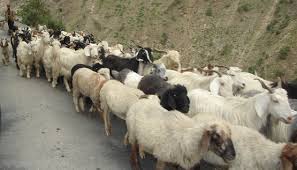The results of research in sheep-breeding were recently reviewed
by Acharya in a discussion paper on breeding strategy for sheep in
India. In addition to reviewing the performance of important pure-bred native
breeds with respect to body weight, wool production and quality, lamb and adult
survival, reproductive performance, etc., the author reviewed the effect of
non-genetic and genetic factors on these traits, estimates of genetic and
phenotypic parameters and the results of selection and cross-breeding
experiments. Through selection within indigenous breeds (Deccani: Khot et
al., Amble et al., ; Bikaneri & Lohi: Nanda &
Singh, ; Khot et al., ; Patanwadi: AHD Gujarat, ;
Bellary: Dass & Rajagopalan,
Body weight at six months is the genetic and phenotypic parameter
which should be utilized in work on improving market weight and ewe
productivity, while an index combining greasy fleece weight and medullation
percentage (weighed negatively) should be used as a reference for improving
wool production and quality in carpet-wool breeds.
Cross-breeding among indigenous breeds has been extensive in
Andhra Pradesh, Karnataka, Tamil Nadu and Uttar Pradesh for improving wool
production and quality and, to some extent, for improving mutton production.
Most of the wool breeds involved were from Rajasthan (Bikaneri, Magra and
Nali). This programme was not fully successful in the southern States, since
the Bikaneri rams did not survive long, presumably because, except in Uttar
Pradesh, they adapted poorly to the hot humid climate. There was however an
improvement in wool production and quality, reflected in an increase in staple
length and a decrease in medullation percentage and average fibre diameter.
Cross-breeding work carried out in the country in general
indicated the superiority in body weight, greasy fleece weight and fleece
quality of half-breds over the indigenous pure-breds involved in crosses,
except for Polwarth crosses with Rampur Bushair in Uttar Pradesh. The survival
of half-breds was similar to that of indigenous breeds involved in the crosses,
but crosses containing higher exotic inheritance did show problems of survival.
Rambouillet appeared to be superior to other exotic breeds in cross-breeding experiments.
When more than one indigenous breed was used with the same exotic breed,
carpet-wool breeds - particularly Magra (Bikaneri) - showed superiority.
Sheep-breeding work under AICRP for fine wool, involving exotic
fine-wool breeds (Soviet Merino and Rambouillet) and indigenous breeds (Gaddi,
Nali, Chokla, Patanwadi, Nilgiri and Bonpala), yielded improvement in greasy
wool production and fleece quality in the half-breds over the native breeds
involved in crosses, but the improvement in greasy wool production was minimal
where the native breed was already producing relatively high quantities of
fleece (e.g. Nali and Chokla). Similarly, the improvement in fleece quality was
minimal in breeds with already reasonably fine fleece, such as Nilgiri.
Cross-breeding experiments for improving mutton under AICRP
involve exotic mutton breeds (Suffolk and Dorset) and indigenous breeds
(Muzzafarnagri, Malpura, Sonadi, Deccani, Mandya and Nellore). The results
available indicate improvements in weight gains and feed conversion efficiency
under individual feed-lot conditions. Suffolk x Sonadi and Dorset x Nellore
half-breds gave the best performance: the lambs attained 30 kg live weight at
six months in individual feed-lot trials with ad libitum feeding
of a ration consisting of 30% roughage and 70% concentrate ration from weaning
(90 days) to 180 days.
At CSWRI, in a breeding experiment involving Rambouillet and three
different indigenous breeds, Chokla (a superior carpet-wool breed), Jaisalmeri
(a medium carpet-wool breed) and Malpura (an extremely coarse and hairy wool
breed), the half-breds were substantially superior in body weight, greasy
fleece production and fleece quality, but beyond 50% exotic fine-wool
inheritance, there was little improvement in body weight and greasy fleece
weight, though there was some further improvement in wool quality. The
performance of progeny produced from inter-breeding half-breds was not much
inferior to that of the first generation (F1) half-breds. The
half-breds pose no more serious management and disease problems under farm
conditions than do native breeds. The Chokla crosses came close to desired
apparel wool, and the Jaisalmeri and Malpura crosses came closer to ideal
carpet wool. The improvement in Malpura was very substantial (almost 200%) in
greasy wool production and in fleece quality.
More recently, research has been undertaken at CSWRI for breeding
sheep for pelt, and Karakul is being crossed with indigenous extremely coarse
carpet-wool breeds. The results achieved have been very encouraging.
Like development, research for improving goat production has been
seriously lacking (AICRP, GB). Cross-breeding indigenous goats with exotic
dairy goats (Alpine and Saanen) resulted in improved milk production and
reproductive performance, but with a slight loss in prolificacy. Some work on
improving meat production by crossing small and large indigenous breeds is in
progress, but the results so far available show only limited promise. After
cross-breeding indigenous goats with Angora for mohair production, it appeared
that with 7/8 Angora inheritance, the crosses produce a similar quantity of
relatively finer quality mohair than that of the Angora controls. Some research
in improving pashmina production has also been undertaken







0 comments:
Post a Comment